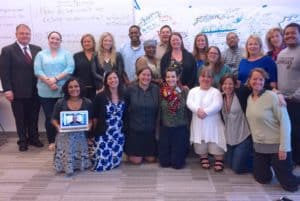
We are excited to announce that Rebecca Pauls, Director of PLAN, has been invited into the Fellowship Program at the Asset-Based Community Development (ABCD) Institute at De Paul University.
Since joining PLAN almost four years ago, Rebecca has led our organization to re-design the network development process to integrate the principles of ABCD with person centred planning, narrative practices and independent facilitation.
Rebecca’s acceptance into this Fellowship program is a recognition of her dedication to the principles of ABCD and the community results achieved through her work and leadership practice. The faculty selected just 23 fellows from across the U.S. and Canada. Throughout the year, fellows will work closely with an ABCD faculty mentor to study and learn about asset based community development in theory and practice. Fellows will also develop a project related to their own work and interests. Please join us in congratulating Rebecca for this achievement.
If you’re unfamiliar with ABCD, here’s a quick overview:
ABCD is based upon three decades of research and community work by John Kretzmann and John McKnight beginning in Chicago in the 1960s. It builds on assets that are found in the community and mobilizes individuals, associations, and organizations to come together to realize and develop their strengths together. There are five main groups in the ABCD approach:
- Individuals – Everyone has assets and gifts: At the centre are residents of the community who all have gifts and skills. Individual gifts and assets need to be recognized and identified. In community development you cannot do anything with people’s needs, only their assets. Deficits or needs are only useful to institutions.
- Associations – People discover each other’s gifts: Small informal groups of people, such as clubs, working with a common interest as volunteers are called associations in ABCD, and are critical to community mobilization. They don’t control anything; they are just coming together around a common interest by their individual choice.
- Organizations – People organize around assets: Paid groups of people that are generally structurally into organizations. They include government agencies and private business, as well as schools, etc. They can all be valuable resources. The assets of these organizations help the community capture valuable resources and establish a sense of civic responsibility.
- Place-based Assets – People here for a reason: Land, buildings, heritage, public and green spaces are all examples of assets for the community. Every place where people choose to be was chosen for good reasons, and whilst people remain those reasons remain. A place might be a centre of natural resources, a hub of activity, living skills, transit connection or marketplace. Whatever the strengths of a place are, the people of the community will be the closest to understanding it.
- Connections – Individuals connect into a community: ABCD recognizes that the exchange between people sharing their gifts and assets creates connections, and these connections are a vital asset to the community. People whose gift is to find and create these connections are called connectors. It takes time to find out about individuals; this is normally done through building relationships, person by person. The social relationships, networks and trust form the social capital of a community.
Rebecca would be more than happy to discuss this Fellowship program, and how the principles of ABCD align with our work at PLAN. Click here to send her an email.
To learn more about ABCD, we invite you to visit the website for the Fellowship Program.
We’d also like to acknowledge our friends at Nurture Development for the helpful description of ABCD above.